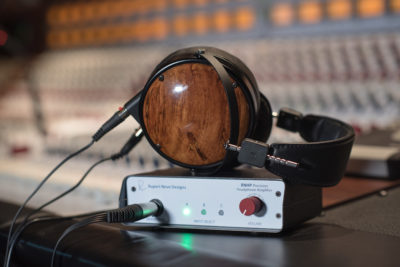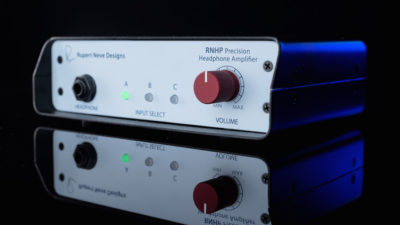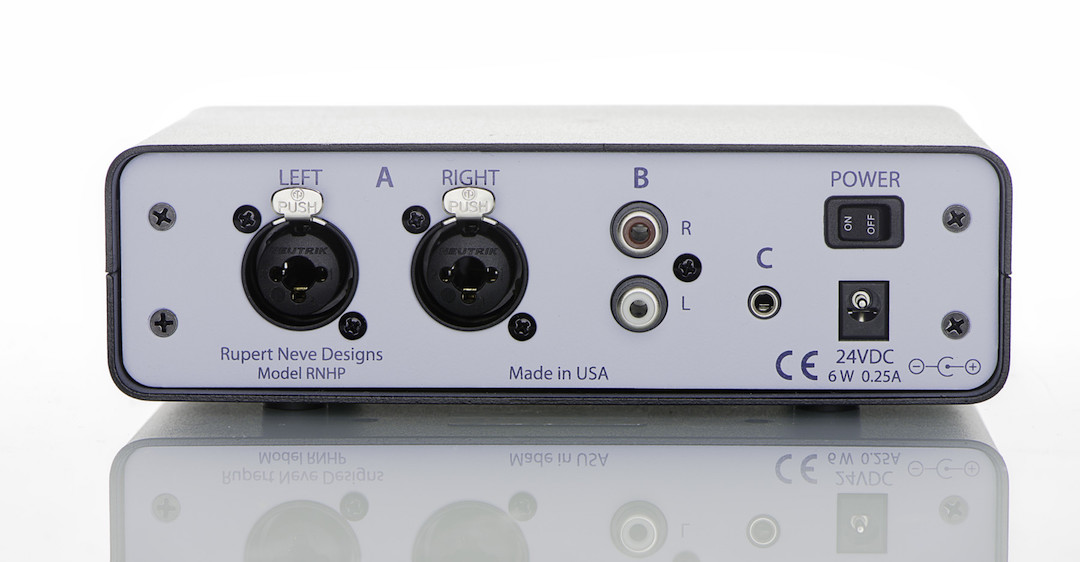New Gear Review: Rupert Neve Designs RNHP Precision Headphone Amplifier
As a musician, producer and engineer who lives in New York City and uses public transport, I have become very familiar with the happy world that is created in my head whether I am monitoring on high quality IEMs (such as the Grado GR10e) en route to some midtown appointment via the 6 train, or sitting comfortably in my own studio, deep in ”mixland” (with my choice of headphones being the open back, over-the-ear PS1000, by Grado, once again.) I also use Sonys and Shures and Apple earbuds. Oh, and real monitors, too.

The Rupert Neve designs RNHP precision headphone amp boasts high quality sound in a compact package, with near zero-ohm load for ultimate transparency.
I listen for balances a lot: Frequency balance, panorama balance, depth of field and ”soundstage” balance and relative level balances.
I listen for how ambience is or is not working, for special effects—not to mention offensive clicks, pops and lip-smacking distractions in a performance. It’s my job as an engineer. But I also love it. And I really dig headphones. I get totally lost in them.
A great mix heard through a great pair of cans is a thing of beauty. It doesn’t have to be full of information and ”events”. A great piano and acoustic bass duo, well recorded, is an entire world when played through headphones. I also love a mix that has little ”sparkles” or “events” that come to life in cans, which can be so dramatic, adding much to the music. Either way, I want to hear everything that was recorded on the tracking date, with clarity and precision in placement.
I have found, for decades, that I can focus on some things in headphones better than I can with studio monitors. I’m not here to denigrate speakers. As great as top quality studio ear-goggles and a great amplifier can be, it’s just a different sound in headphones, a different process and perception. Headphones are a tool that I use every day. Whether I’m working on a project or just listening for personal enjoyment, what I hear when listening to music with them is a massive part of my life.
As great as your choice of headphones are, much like when it comes to your choice of monitors, the amplifier that feeds those speakers is a crucial part of the quality of your listening experience. I don’t care if it’s vinyl, MP3, a WAV file—the amp is a part of the equation.
In my mix studio, I depend on the Grado PS1000s, as mentioned. But I also depend on my SPL Phonitor2, the Grace m9XX, the headphone out of my SSL desk, the SPL 2Control and even the headphone output of a laptop at times.
The best setup for me so far has been the Grados and Phonitor2. A pretty great pairing. Detail, every “balance” I need, fantastic fidelity and integrity—I hear what I tracked in the first place. I hear the strengths and weaknesses in capture and performance. And I can, again, depend on what this pairing is telling me about what I am hearing. It’s also the setup that I am used to, which helps.
A couple of days ago however, Rupert Neve Designs sent me their new RNHP Precision Headphone Amplifier for a test run. I’ve been listening a lot since it’s arrival, comparing the RNHP to both the SPL units and the Grace, mostly.
So far, I’m pretty impressed.
Features and Use
Rupert Neve Designs engineered this RNP to have an output impedance as close to zero ohms as possible, in order to help minimize the frequency-based reactive-load impedance shifts that are a problem unique to headphone monitoring.
This feature is intended to provide unerring accuracy, and to minimize frequency response shifts that may occur when you’re switching between multiple pairs of headphones to evaluate a mix.
The low end, while not being quite as pronounced or extended as I perceive with the Phonitor2 is very realistic, accurate and focused. It seemed far better to me than the Grace DAC in that regard.
I have to say that I preferred the lows on the RNHP to the lows on the SPL 2Control as well…ever so slightly—but I preferred it. I am also enjoying a particular warmth and realism in the hi-mids, listening to Joni Mitchell’s Hejira as I type this. The highs are airy and non-fatiguing—nothing harsh at all.
Overall, the frequency response is balanced and just…lovely. Warm, silky and with plenty of punch when needed. (Have a listen to Donald Fagen’s ”Pixaleen” and say thanks to Mr. Elliot Scheiner!) I listened to a wonderful recording of the Rodrigo classic ”Concierto de Aranjuez” this morning with the RNHP – and I was certainly there in the hall with the orchestra. I keep asking myself, “How did they get the stereo image so wide, so accurate, so perfect?”
The RNHP has a clarity that is far better than anything I have heard from any competitor near this price point. Funny, much like my recent experience with the new RNDI direct box, I want to tell them they are pricing too low! But then again, perhaps the guys at RND just seem to be making better products at a more realistic price.
The Phonitor2 is nearly four times the price, and yes, I did find it even better sounding and more precise than the RNHP. I would expect (and hope) that to be this case with such a difference in price and features. But if you compare the specs on these two units, things are not too different at all. Of course, the Phonitor2 has the entire headphone matrix, so it’s a different beast in a way. But as a dedicated heaphone amp? Well, you’ll be hard pressed to find much better than the RNHP.
I immediately knew that I will find myself traveling with the RNHP. I’ll take it to use in other control rooms when engineering as I know for sure I can trust it for translation and critical listening, and I will certainly be taking it with me to tracking sessions when I am part of the band. Compared to the newer 24 channel personal mixers available now in many tracking rooms, using a headphone amp of the quality of the RNHP along with a truly great set of closed headphones is going to make my performance better. I have little doubt of this.
Connectivity comes in the form of a single 1/4” stereo output on the front, and XLR/TRS combo jacks, RCA and 1/8” on the back. All three inputs sound great, are switchable from the very clean front panel, thanks to a set of compact push-button LED switches.
Does it have enough headroom? No question about it—tons to spare.
The RNHP can take in 22.8 dBu, +14.7dBu or +3.3dBu @1kHz respectively from its combo, RCA and 1/8” jacks, respectively. It can put out as much as a clean 300mW RMS depending on the headphones, with a frequency response that’s off by no more than +/- .2dB from 10Hz to 120KHz and a noise floor as low as -101.9dBV for its combo jack inputs.
Put more simply, I like what I am hearing. It’s the Rupert Neve Mojo. Trademark that, guys: ”RNM”.
Please note: When you buy products through links on this page, we may earn an affiliate commission.









Plush
June 14, 2016 at 6:48 pm (8 years ago)I cannot get the unit to play loudly enough out of my tape recorder.